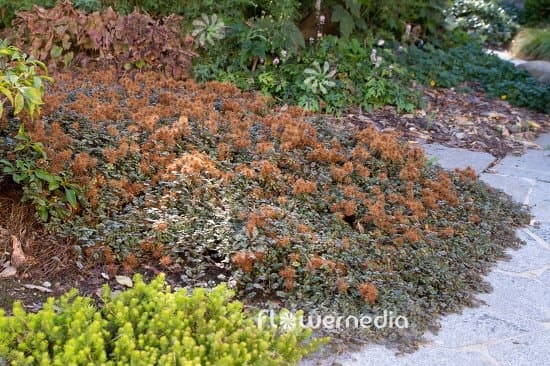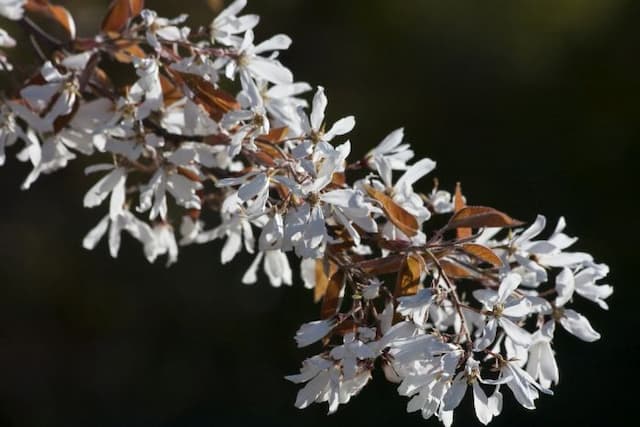Great burnet 'Martin's Mulberry' Sanguisorba officinalis 'Martin's Mulberry'

ABOUT
'Martin's Mulberry' is a clump-forming perennial, to 1.8m tall, with leaves comprised of up to 15 oval to oblong leaflets. Wine-red to deep purple flowers are held above the foliage on self-supporting stems from summer into autumn
About this plant
 Names
NamesSynonyms
Great Burnet, Officinal's Burnet, Garden Burnet.
Common names
Poterium officinale (L.) A.Gray, Sanguisorba minor subsp. muricata (Spach) Briq., Sanguisorba minor var. muricata (Spach) Ces., Sanguisorba officinalis var. longifolia (Bertol.) Nyman, Sanguisorba officinalis var. microcephala (Simonk.) Hayek, Sanguisorba villosa (D.Don) Wall. Ex G.Don.
 Characteristics
CharacteristicsLife cycle
Perennials
Foliage type
Deciduous
Color of leaves
Green
Flower color
Red
Height
3-4 feet (0.91-1.22 meters)
Spread
2-3 feet (0.61-0.91 meters)
Plant type
Herb
Hardiness zones
4-9
Native area
Temperate Northern Hemisphere
Benefits
 General Benefits
General Benefits- Attracts Pollinators: Provides nectar and pollen for bees, butterflies, and other beneficial insects, enhancing biodiversity.
- Low Maintenance: Once established, Great Burnet is drought-tolerant, requiring minimal care and upkeep.
- Soil Stabilization: Its deep root system helps prevent soil erosion, especially useful on slopes or in areas with loose soil.
- Aesthetic Appeal: Offers visual interest with its red bottlebrush-like flower spikes and blue-green foliage, ideal for ornamental gardens.
- Seasonal Interest: Blooms in the summer to late summer, providing color and texture when many other plants start to fade.
- Wildlife Habitat: Seeds can provide food for birds, while the plant itself offers shelter and breeding spots for various insects.
- Culinary Use: Young leaves are sometimes used in salads and other dishes, mostly in traditional regional cuisines.
- Drought Tolerance: Once established, can survive in dry conditions, making it suitable for xeriscaping and water-wise gardens.
- Tolerant of Different Soil Types: Can grow in a range of soil conditions from clay to sand, as long as it's well-drained.
 Medical Properties
Medical Properties- Antioxidant activity: Contains compounds that may help in scavenging free radicals, thus protecting cells from oxidative stress.
- Antibacterial effects: Extracts have been found to exhibit antibacterial properties against certain strains of bacteria.
- Hemostatic action: Traditionally used to reduce bleeding and help in the clotting process.
- Anti-inflammatory properties: May help to reduce inflammation and soothe irritated tissues.
- Gastrointestinal benefits: Used in traditional medicine to treat gastrointestinal issues such as diarrhea and dysentery.
 Air-purifying Qualities
Air-purifying QualitiesThis plant is not specifically known for air purifying qualities.
 Other Uses
Other Uses- Sanguisorba officinalis 'Martin's Mulberry', commonly known as Great Burnet, can be used as a natural fabric dye, creating subtle hues of yellow to green depending on the mordant used.
- In traditional Japanese cuisine, Great Burnet leaves are sometimes used as a flavoring ingredient in certain dishes for their cucumber-like taste.
- The plant's tannin-rich roots can be used in the tanning of leather to enhance color and durability.
- Great Burnet can be added to compost piles as a source of important nutrients and to stimulate the composting process.
- As an ornamental plant, it finds use in landscape design for providing textural contrast with its unique, dense flower heads and pinnate leaves.
- The dried flower heads of Great Burnet can be used in floral arrangements and as part of natural crafts or potpourri mixtures due to their interesting shape and longevity.
- Because of its dense growth habit, it can be used as a natural ground cover to suppress weeds in garden beds.
- Its long-lasting flowers make Great Burnet an excellent choice for cut flower gardens where it provides material for bouquets and decorations.
- Seed heads from the plant can be used to feed birds during the winter months when other food sources are scarce.
- In the art of pressed flowers, the leaves and blooms of Great Burnet can be used for creating decorative botanical prints and cards.
Interesting Facts
 Feng Shui
Feng ShuiThe Great Burnet is not used in Feng Shui practice.
 Zodiac Sign Compitability
Zodiac Sign CompitabilityThe Great Burnet is not used in astrology practice.
 Plant Symbolism
Plant Symbolism- Healing - Sanguisorba officinalis, commonly known as Great Burnet, has a long history in herbal medicine for its astringent and cooling properties, symbolizing the ability to heal physical wounds and ailments.
- Protection - The Great Burnet has been associated with warding off negative influences and providing protection due to its robust nature and traditional use in folk remedies.
- Balance - Its presence in wet meadows and natural affinity for balancing water levels in the soil, Great Burnet signifies maintaining balance in life and environments.
 Water
WaterGreat Burnet prefers consistently moist soil, especially during the growing season. Water the plant thoroughly when the top inch of soil feels dry to the touch. This may mean watering once or twice a week, depending on weather conditions and soil type. It's important to avoid over-watering which can lead to root rot. An estimated amount would be approximately a gallon of water every week for an established plant, but this can vary. The key is to observe the soil moisture and adjust the watering accordingly.
 Light
LightGreat Burnet thrives best in full sun to partial shade. An ideal spot would be an area that receives at least 4 to 6 hours of direct sunlight daily, with some afternoon shade in hotter climates to protect the plant from intense heat. Avoid deep shade as this will reduce the plant's vigor and flowering capability.
 Temperature
TemperatureGreat Burnet performs well in a wide range of temperatures, suitable for USDA zones 4 through 8. It can handle minimum winter temperatures down to -30°F and summer temperatures as high as 90°F, but the ideal growth temperature range is between 60°F and 75°F. The plant is cold-hardy and can tolerate frost without significant damage.
 Pruning
PruningPruning Great Burnet is typically done to maintain plant shape and remove spent flower spikes to encourage reblooming or to prevent self-seeding. It is best to prune after flowering, cutting back the flower stems to the base. Additionally, you can cut the plant back to ground level in late fall or early spring to tidy up the plant and stimulate new growth.
 Cleaning
CleaningAs needed
 Soil
SoilGreat Burnet thrives in well-draining soil with rich organic matter. A mix of loam, compost, and sand would be ideal to facilitate drainage while retaining moisture. The soil pH should be neutral to slightly acidic, between 6.0 and 7.0, for optimal growth conditions.
 Repotting
RepottingGreat Burnet does not need frequent repotting and thrives best when left undisturbed. Repot every 2-3 years or when the plant becomes root-bound to maintain its health and vigor.
 Humidity & Misting
Humidity & MistingGreat Burnet prefers moderate humidity levels, as it is tolerant of a range of environmental conditions. Ensure it has good air circulation to prevent issues with too high humidity.
 Suitable locations
Suitable locationsIndoor
Provide bright indirect light and keep compost moist.
Outdoor
Plant in partial shade, enrich soil with organic matter.
Hardiness zone
4-9 USDA
 Life cycle
Life cycleGreat Burnet 'Martin's Mulberry' begins its life cycle as a seed, which when sown in fertile, well-drained soil and exposed to the right conditions—cool temperatures and moisture—will germinate and produce small seedlings. These seedlings develop into rosettes of pinnately compound leaves at ground level, and as the plant matures, it will produce tall flower stalks bearing reddish-purple, tightly clustered, spherical flower heads in the summer. After pollination, often by insects, the flowers will develop into small dry fruits (achenes). These seeds are then dispersed, either by wind, water, or animal activity, to start new plants in surrounding areas. Great Burnet is a perennial herb, so after the flowering and seed dispersal stage, the aerial parts of the plant may die back in the fall, but the rootstock survives through winter. In the spring, new growth resumes from the perennial rootstock, repeating the cycle.
 Propogation
PropogationPropogation time
Spring-Early Summer
The Sanguisorba officinalis 'Martin's Mulberry', commonly known as Great Burnet, is often propagated by division, which is a straightforward process usually undertaken in early spring or autumn. To propagate by division, carefully lift the mature plant from the ground with a shovel, ensuring a good clump of roots remains with each division. Gently separate the plant into smaller sections, each with several growth points and a portion of the root system. Replant the divisions immediately at the same soil level at which they were previously growing, spacing them about 12 to 24 inches (roughly 30 to 60 cm) apart to allow for adequate growth room. Water the new plants thoroughly to help establish the roots in their new locations. This method of propagation is simple, efficient, and helps to rejuvenate older plants that may have become too crowded, while also providing new plants for the garden.

![Tree amelanchier [Tradition]](/_next/image?url=https%3A%2F%2Fplants-admin.emdemapps.com%2Fimages%2Fplants%2F%2Fimages%2F604b56afa99a2.png&w=640&q=75)




![Strawberry [Just Add Cream]](/_next/image?url=https%3A%2F%2Fplants-admin.emdemapps.com%2Fimages%2Fplants%2F%2Fimages%2F604b5f8e7d168.png&w=640&q=75)


